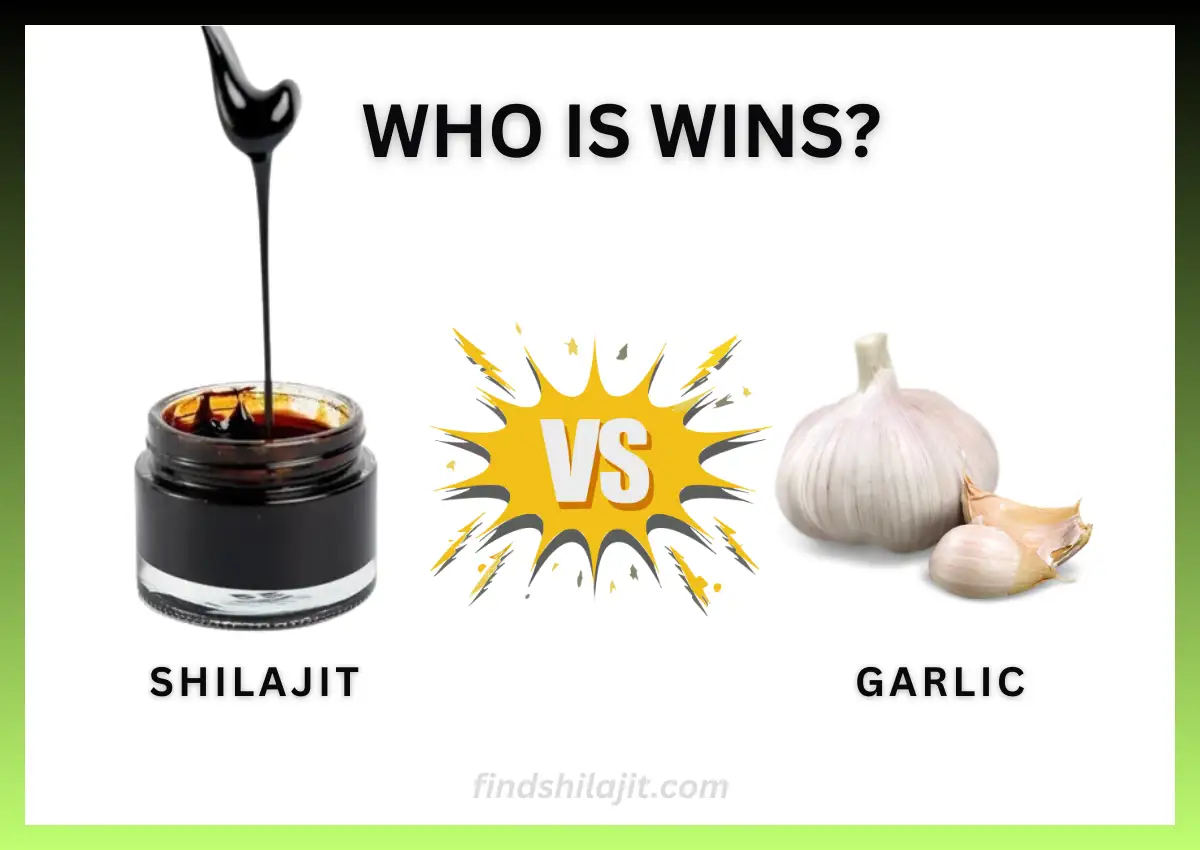I still remember the first time I heard about mixing shilajit and garlic—it was from an old Ayurvedic practitioner in Rishikesh.
He said, “Nature’s two warriors can fight many battles inside the body.” At first, I thought it sounded a bit odd. After all, one is a mineral-rich resin that seeps from Himalayan rocks, and the other is a pungent kitchen staple.
Did You Know?
Shilajit helps balance blood sugar levels
Both have been part of traditional wellness systems for centuries in the world. Shilajit, often called “the destroyer of weakness” in Ayurveda, is rich in fulvic acid and minerals.
Image Credit: Created with AI only for education
Garlic, on the other hand, is packed with allicin, antioxidants, and compounds known for supporting heart and immune health.
Today, people around the world are curious about combining these two for better energy, stamina, and overall health and well-being.
A quick glance at Google Trends shows a steady rise in searches for “shilajit” over the past five years, showing growing interest among health-conscious readers.
But is it actually a good idea to take them together? Can it be safe and, more importantly, effective? In this article, I’ll walk you through what science, Ayurveda, and personal experience have to say—so you can decide if this combo belongs in your wellness routine.
What is Shilajit?
Shilajit is a natural, tar-like substance that forms over centuries in high mountain ranges, mainly the Himalayas, Altai, Caucasus, and Gilgit-Baltistan regions.
It is created from the gradual decomposition of living plants and microbial matter trapped between rock layers.
Heat from the sun and pressure from the mountains cause it to seep out as a sticky resin during warmer months.
High-quality shilajit contains more than 80 minerals in ionic form, making them easier for the body to absorb.
The most important compounds in shilajit are fulvic acid and humic acid, which help transport nutrients into cells and remove toxins from the body.
It also contains dibenzo-alpha-pyrones, amino acids, and trace elements like iron, zinc, and magnesium.
Why People Use Shilajit
Shilajit is used in both Ayurveda and modern supplements for its potential health benefits, such as:
- Energy and Stamina – It enhances ATP production in cells, helping reduce fatigue.
- Sex Drive and Fertility – Some studies suggest shilajit improves testosterone levels and sperm quality in men.
- Immunity Support – Fulvic acid and antioxidants may help strengthen immune defenses.
- Cognitive Health – Early research indicates it may protect brain function by reducing oxidative stress.
Possible Side Effects
While pure, tested shilajit is generally safe for most healthy adults, some side effects can occur:
- Initially, you might feel digestive discomfort (loose stool, stomach upset)
- Allergic reactions in sensitive individuals
- Lower blood pressure in some cases
- Risk of heavy metal contamination if not purified properly
Daily Recommended Dosage
Ayurvedic guidelines and many supplement manufacturers generally recommend 300–500 mg per day of purified shilajit resin for adults.
It is best taken once or twice daily, dissolved in lukewarm water or milk. Dosage should be adjusted based on age, health condition, and the form of shilajit used.
What is garlic?
Garlic (Allium sativum) is a bulbous plant belonging to the onion family. It has been cultivated for thousands of years in Central Asia and the Mediterranean region.
Historically, it has been used both as food and medicine in ancient Egypt, Greece, China, and India.
Garlic is rich in sulfur compounds, the most notable being allicin, which is formed when garlic is chopped or crushed.
It also contains manganese, vitamin B6, vitamin C, selenium, and small amounts of calcium, copper, potassium, iron, and phosphorus. The combination of these nutrients contributes to its strong medicinal properties.
Why People Use Garlic
Garlic is consumed for its flavor and health benefits. Common uses include:
- Heart Health – May help lower blood pressure and cholesterol levels.
- Immune Support – Antimicrobial and antiviral properties may strengthen the body’s defenses.
- Antioxidant Effects – Helps protect cells from damage caused by free radicals.
- Anti-inflammatory Benefits – May help reduce inflammation and improve circulation.
- Digestive Health – Supports gut health and promotes healthy digestion.
Possible Side Effects
While garlic is safe for most people when consumed in normal amounts, high doses or supplements can cause:
- Bad breath and body odor
- Heartburn or upset stomach
- Increased risk of bleeding when taken with blood-thinning medications
- Allergic reactions in rare cases
Daily Recommended Dosage
Health experts often suggest 1–2 raw garlic cloves per day for general wellness. For supplements, doses usually range from 300–1,000 mg of garlic extract daily, depending on the intended use. Cooking garlic can reduce its allicin content, so many prefer consuming it raw or lightly cooked.
Garlic vs Roasted Garlic vs Shilajit: A Full Comparison
| Parameter | Raw Garlic | Roasted Garlic | Shilajit |
| Origin | Bulb from Allium sativum plant | Bulb from Allium sativum, cooked at high heat | Natural resin formed in mountain rocks over centuries |
| Main Active Compounds | Allicin, sulfur compounds, antioxidants | Reduced allicin due to heat, sweeter flavor | Fulvic acid, humic acid, 80+ minerals |
| Additional Active Compounds | Selenium, manganese, vitamin C, flavonoids | Trace antioxidants, caramelization-derived compounds | Dibenzo-alpha-pyrones, amino acids, triterpenes |
| Primary Health Benefits | Strong antimicrobial and heart health support; boosts immunity | Milder antioxidant benefits; easier on digestion | Energy boost, stamina, immunity, hormone balance |
| Taste & Aroma | Pungent, sharp, strong odor | Sweet, caramelized, milder smell | Earthy, bitter, mineral-like |
| Best For | Cardiovascular support, immune defense | Gentle digestion, flavor enhancement in food | Energy, vitality, recovery, mineral replenishment |
| Daily Recommended Intake | 1–2 raw cloves (3–6g) | Similar weight as raw, but less potent | 300–500 mg purified resin or powder |
| Possible Side Effects | Bad breath, heartburn, bleeding risk | Minimal odor, less digestive irritation | Loose stool, low BP, heavy metal contamination risk if impure |
| Storage | Cool, dry place | Cool, dry place after roasting | Airtight container, away from heat/moisture |
| Usage in Ayurveda/Traditional Medicine | Yes | Rarely used medicinally | Yes—classified as a Rasayana (rejuvenator) |
Can We Eat Shilajit and Garlic Together?
From my own use and research, there’s no solid scientific evidence showing any harmful direct interaction between shilajit and garlic for healthy adults.
Image Credit: Created with AI only for education
In fact, both work through different bioactive pathways—garlic’s allicin supports heart and immune health, while shilajit’s fulvic acid boosts energy and nutrient absorption.
Ayurveda often blends Rasayana herbs like shilajit with potent spices such as garlic, ginger, and honey to balance ojas (vital energy) and enhance resilience.
But first, you should know what type of body so that you can use the shilajit benefits to the maximum.
Still, the key is moderation and ensuring both are from pure, quality sources.
Benefits of Shilajit and Garlic Together
Image Credit: Created with AI only for education
When taken in the right amount, combining shilajit and garlic may offer unique advantages:
- Enhanced Nutrient Uptake – Fulvic acid in shilajit may improve the absorption of garlic’s sulfur compounds, making them more bioavailable.
- Support for Healthy Blood Sugar – Some studies suggest shilajit may aid glucose metabolism, and garlic may help regulate insulin sensitivity.
- Joint and Bone Health – The minerals in shilajit, along with garlic’s anti-inflammatory compounds, may help ease stiffness and support bone density.
- Better Oxygen Utilization – Shilajit is known to improve mitochondrial function, while garlic may enhance blood flow, leading to better oxygen delivery to muscles.
- Adaptogenic Support—Shilajit’s adaptogenic properties may help the body cope with stress, and garlic’s antioxidant effects may protect against stress-induced cell damage.
- Liver Detox Assistance – Both may support the liver’s detox pathways, shilajit through mineral support and garlic through sulfur-based cleansing compounds.
- Altitude Performance – Shilajit is traditionally used in high-altitude regions for endurance, and garlic may further help improve circulation and oxygen capacity.
How to Consume Garlic with Shilajit
- Morning Empty Stomach – Crush 1 clove of raw garlic, swallow with warm water, then take your shilajit (300–500 mg) dissolved in lukewarm water or milk after 10–15 minutes.
- Garlic-Honey Mix + Shilajit – Take minced garlic mixed with a teaspoon of honey, followed by shilajit resin in warm milk.
- Lightly Cooked Garlic in Meals – Add roasted or sautéed garlic to food, then take shilajit separately to preserve active compounds.
- Avoid Together in Same Cup – Consume them separately for better absorption and to avoid an overpowering taste.
Who Should Avoid This Combination?
- Pregnant or breastfeeding women should avoid.
- People on blood thinners may increase bleeding risk.
- Those with garlic allergy or sensitive digestion – Can trigger stomach upset or reactions.
FAQs
Can I take shilajit and garlic daily?
Yes, but use only if healthy and in moderate amounts.
Should I eat them together or separately?
Separately is better for taste and absorption. Don’t use it at the same time.
Can they boost workout performance?
Yes, they may improve stamina and recovery.
Is cooked garlic effective with shilajit?
Yes, but raw garlic has more active compounds.
Do I need to cycle shilajit use?
Many experts suggest breaks after 2–3 months.
At Last
Hope you like my post, as we learned how shilajit and garlic together can be a powerful wellness duo, supporting energy, immunity, and nutrient absorption.
While both have unique bioactive compounds, their combined effects may enhance circulation, endurance, and recovery.
Safe for most healthy adults, they work best when consumed in moderation and from pure sources. Always consult a healthcare provider before adding them to your daily routine.
Please let us know your feedback via comments below.
Also Read: Shilajit and Garlic: Can We Eat Them Together?
References:
Shilajit: A Natural Phytocomplex with Potential Procognitive Activity
Potential Health Benefit of Garlic Based on Human Intervention Studies: A Brief Overview
Disclaimer
This article is for informational purposes only. Please consult a licensed healthcare provider before starting any new supplement, especially if you are pregnant, breastfeeding, or on medication.



